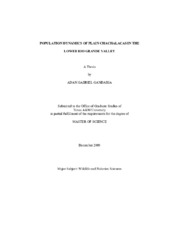| dc.description.abstract | The Lower Rio Grande Valley (LRGV) of Texas is an ecologically diverse region in the United States and marks the northernmost extension for many tropical species of plants and animals. Since the early 1900s, 95% of the native Tamaulipan brushlands have been cleared due to agricultural practices and urban development. The plain chachalaca (Ortalis vetula) is a medium sized bird endemic to the native brushlands of the LRGV.
In 2003, I trapped and radio-tagged 29 birds (16 males, 13 females) to evaluate the effects of fragmentation on the population dynamics (i.e., survival, mortality, and movements) of this brushland species. My study objectives were to estimate (1) seasonal survival of chachalacas by sex, and (2) ranges, core areas, and movements using radio telemetry.
Mammalian predation (43%, n = 6) and unknown (43%, n = 6) deaths accounted for the majority of mortality observed. I found no difference (P > 0.05) in estimated 8-month survival (December 2003-July 2004) between males (S = 0.364, SE = 0.132) and females (S = 0.405, SE = 0.153). In comparing seasonal survival for all birds (males and females combined), I observed a difference (P < 0.05) in survival between the nesting (S = 0.414, SE = 0.103) and breeding seasons (S = 0.917, SE = 0.079). Female ranges (x‾ = 117 ha, range = 42–177 ha) and core areas (x‾ = 23 ha, range = 5–46 ha) during the nesting season were larger than male ranges (x‾ = 41 ha, range = 31–46 ha) and core areas (x‾ =10 ha, range = 7–14 ha) during the same period. During the breeding season, female ranges (x‾ = 59 ha, range = 10–188 ha) and core areas (x‾ = 9 ha, range = 2–33 ha) were similar to male ranges (x‾ = 48 ha, range = 4–130 ha) and core areas (x‾ = 9 ha, range = 1–23 ha).
Mean distances between seasons were similar for both sexes (females, nesting, x‾ = 486, breeding, x‾ = 345; males, nesting, x‾ = 184, breeding, x‾ = 292), though females distances generally were greater. Dispersal defined as movement off the Santa Ana National Wildlife Refuge was observed for 3 birds. In 2 cases, a radio-tagged female and male were observed crossing the Rio Grande River (approximately 100-m wide) to habitat in Mexico.
Study results suggested mammalian predation may limit the growth of chachalaca populations. Though land use changes such as agricultural uses may not directly limit chachalaca populations in providing cover and food, concentration of populations in remnant native brushlands may serve as ecological “sinks” to the species. Greater range and movement data observed in my study may be attributed to suboptimal habitat (i.e., increased fragmentation) for plain chachalacas. | en |


